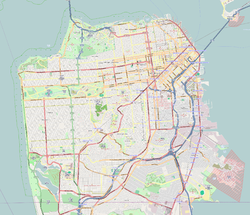Old Spaghetti Factory Cafe
| Old Spaghetti Factory Cafe | |
|---|---|
| Location | 478 Green Street, San Francisco, California, U.S. |
| Coordinates | 37°48′00″N 122°24′26″W / 37.7999°N 122.4071°W |
| Built | 1908 |
| Architect | Unknown[1] |
| Designated | 1981-06-07 |
| Reference no. | 127[2] |
The Old Spaghetti Factory Cafe is a historic commercial building, first built for industrial purposes in 1908, located in North Beach, San Francisco. It was converted from a spaghetti factory to a restaurant by Frederick Walter Kuh in 1956.[1][3] It was listed as a San Francisco Designated Landmark on June 7, 1981.[2]
History
[edit]The building that would later become the Old Spaghetti Factory Cafe was originally a "barn like, wood-frame building", first constructed after the 1906 San Francisco earthquake. It was first used to manage imported olive oil and cheese; it was later used as a factory for bottling seltzer water. Before it became the restaurant, it was owned by three Italian-American men named Baccigalupi, Casaretto, and Demartini, who operated a spaghetti factory out of it. The building was heavily damaged in a fire in January 1954, requiring later remodeling.[4][5]
Frederick Walter Kuh first moved to San Francisco in 1954, where he worked at a nightclub, The Purple Onion. He opened the restaurant, also described as a nightclub and a cabaret club, after pressure from friends over finding a new place to store his collection of Victorian style furniture in 1956.[3] He recruited his friend George Donald Currie, who had experience running a nightclub in Paris after World War II, to run the kitchen.[6][7] The restaurant quickly became a popular hangout spot, and Kuh was later said to be the "father of funk" by journalist Herb Caen.[4] Kuh retired in 1984 and sold the restaurant.[3]
Legacy
[edit]Robin Williams performed at the Old Spaghetti Factory Cafe early in his career, and participated in a "Save the Old Spaghetti Factory!" benefit in the 1980s.[1][8] Adlai Stevenson II used it as an "unofficial local headquarters" for his 1956 presidential campaign.[3] The Macaroni Show, a 1962 variety show that evolved into Beach Blanket Babylon, and Donald Pippin's Pocket Opera started in the "Blue Noodle Room" at the Old Spaghetti Factory Cafe.[4]
The new owner of the building that housed the Old Spaghetti Factory Cafe was issued a cease and desist order for modifying a Historic Landmark building without proper approval on February 1, 1985, the first time that any incidents had happened since the system had been established. He was fined $500 (equivalent to $1,462 in 2024) for each day that the building was in non-compliance.[9]
References
[edit]- ^ a b c "San Francisco City Planning Comission Resolution No. 8882" (PDF). SF Planning GIS. Archived (PDF) from the original on June 15, 2025. Retrieved June 14, 2025.
- ^ a b "SAN FRANCISCO PRESERVATION BULLETIN NO. 9" (PDF). SF Planning. Archived (PDF) from the original on February 11, 2024. Retrieved June 14, 2025.
- ^ a b c d Pimsleur, J.L. (November 12, 1997). "OBITUARY -- Frederick Walter Kuh". SFGate. Archived from the original on April 8, 2024. Retrieved June 15, 2025.
- ^ a b c Noyes, Mary Tolaro (May 2001). "Freddy Kuh's Victorian Kitsch, Declasse Furniture, Baubles and Gewgaws". The Semaphore. No. 156. Telegraph Hill Dwellers. pp. 26–27, 32.
- ^ Petrin, Katherine (February 2012). "The Old Spaghetti Factory: Unassuming and Significant". The Semaphore. No. 197. Telegraph Hill Dwellers. p. 4.
- ^ "CURRIE, George Donald". SFGate. April 7, 2002. Archived from the original on July 4, 2020. Retrieved June 15, 2025.
- ^ Stout, Doug (November 3, 2018). "Veteran column: Currie taken prisoner during WWII". The Newark Advocate. Archived from the original on February 2, 2023. Retrieved June 15, 2025.
- ^ Hartlaub, Peter; Garchik, Leah; Lewis, David (August 12, 2014). "Robin Williams' heart never strayed far from San Francisco". SFGate. Archived from the original on May 12, 2025. Retrieved June 15, 2025.
- ^ "Old Spaghetti Factory Cafe Cease and Desist Order". Telegraph Hill Semaphore. No. 90. Telegraph Hill Dwellers. February 1985. pp. 16–17.

